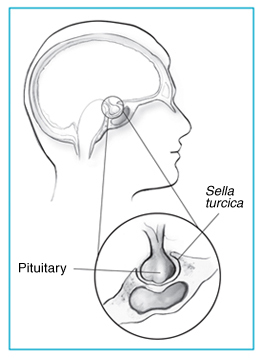Sella turcica
(Redirected from Hypophysial fossa)
Saddle-shaped depression in the sphenoid bone of the human skull
| Sella turcica | |
|---|---|
| Sella turcica.jpg | |
| Sella turcica shown in red | |
| General Information | |
| Latin | |
| Greek | |
| TA98 | |
| TA2 | |
| FMA | |
| Details | |
| System | |
| Artery | |
| Vein | |
| Nerve | |
| Lymphatic drainage | |
| Precursor | |
| Function | |
| Identifiers | |
| Clinical significance | |
| Notes | |
The sella turcica (Latin for "Turkish saddle") is a saddle-shaped depression in the body of the sphenoid bone of the human skull. It is located in the middle cranial fossa, a central depression in the floor of the cranial cavity. The sella turcica is an important anatomical landmark because it houses the pituitary gland.
Anatomy
The sella turcica is bounded by the tuberculum sellae anteriorly and the dorsum sellae posteriorly. The hypophyseal fossa, the deepest part of the sella turcica, contains the pituitary gland. The sella turcica is covered by a dural fold called the diaphragma sellae, which has an opening for the passage of the pituitary stalk.
Function
The primary function of the sella turcica is to protect and support the pituitary gland. The pituitary gland, also known as the hypophysis, is a crucial endocrine gland that regulates various physiological processes through the secretion of hormones.
Clinical significance
Abnormalities in the size or shape of the sella turcica can be indicative of various medical conditions. For example, an enlarged sella turcica may be associated with a pituitary adenoma, a benign tumor of the pituitary gland. Other conditions that can affect the sella turcica include empty sella syndrome, where the sella turcica appears empty on imaging due to the flattening of the pituitary gland, and craniopharyngioma, a type of brain tumor that can affect the region.
Imaging
The sella turcica can be visualized using various imaging techniques, including X-ray, computed tomography (CT), and magnetic resonance imaging (MRI). These imaging modalities are essential for diagnosing abnormalities of the pituitary gland and surrounding structures.
See also
References
Transform your life with W8MD's budget GLP-1 injections from $125.
W8MD offers a medical weight loss program to lose weight in Philadelphia. Our physician-supervised medical weight loss provides:
- Most insurances accepted or discounted self-pay rates. We will obtain insurance prior authorizations if needed.
- Generic GLP1 weight loss injections from $125 for the starting dose.
- Also offer prescription weight loss medications including Phentermine, Qsymia, Diethylpropion, Contrave etc.
NYC weight loss doctor appointments
Start your NYC weight loss journey today at our NYC medical weight loss and Philadelphia medical weight loss clinics.
- Call 718-946-5500 to lose weight in NYC or for medical weight loss in Philadelphia 215-676-2334.
- Tags:NYC medical weight loss, Philadelphia lose weight Zepbound NYC, Budget GLP1 weight loss injections, Wegovy Philadelphia, Wegovy NYC, Philadelphia medical weight loss, Brookly weight loss and Wegovy NYC
|
WikiMD's Wellness Encyclopedia |
| Let Food Be Thy Medicine Medicine Thy Food - Hippocrates |
Medical Disclaimer: WikiMD is not a substitute for professional medical advice. The information on WikiMD is provided as an information resource only, may be incorrect, outdated or misleading, and is not to be used or relied on for any diagnostic or treatment purposes. Please consult your health care provider before making any healthcare decisions or for guidance about a specific medical condition. WikiMD expressly disclaims responsibility, and shall have no liability, for any damages, loss, injury, or liability whatsoever suffered as a result of your reliance on the information contained in this site. By visiting this site you agree to the foregoing terms and conditions, which may from time to time be changed or supplemented by WikiMD. If you do not agree to the foregoing terms and conditions, you should not enter or use this site. See full disclaimer.
Credits:Most images are courtesy of Wikimedia commons, and templates, categories Wikipedia, licensed under CC BY SA or similar.
Contributors: Prab R. Tumpati, MD






